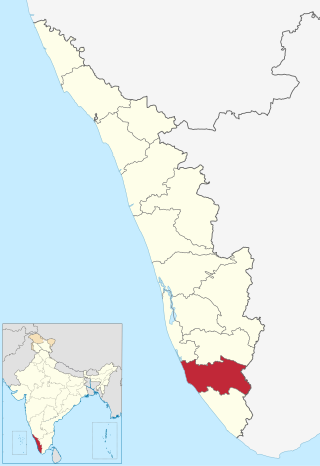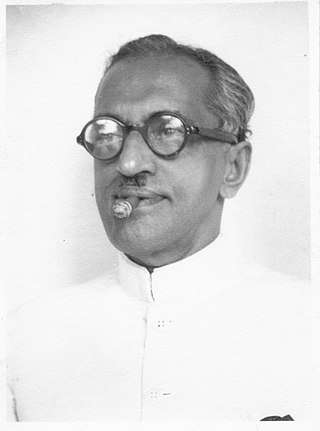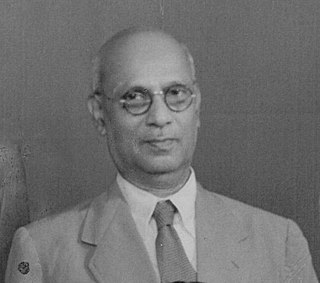
The Kingdom of Travancore, also known as the Kingdom of Thiruvithamkoor, was an Indian kingdom from c. 1729 until 1949. It was ruled by the Travancore Royal Family from Padmanabhapuram, and later Thiruvananthapuram. At its zenith, the kingdom covered most of the south of modern-day Kerala and the southernmost part of modern-day Tamil Nadu with the Thachudaya Kaimal's enclave of Irinjalakuda Koodalmanikyam temple in the neighbouring Kingdom of Cochin. However Tangasseri area of Kollam city and Anchuthengu near Attingal in Thiruvananthapuram were parts of British India.

Kollam, also known by its former name Quilon, is an ancient seaport and city on the Malabar Coast of India bordering the Laccadive Sea, which is a part of the Arabian Sea. It is 71 km (44 mi) north of the state capital Thiruvananthapuram. The city is on the banks of Ashtamudi Lake and the Kallada river. Kollam is the fourth largest city in Kerala and is known for cashew processing and coir manufacturing. It is the southern gateway to the Backwaters of Kerala and is a prominent tourist destination. Kollam is one of the most historic cities with continuous settlements in India. The Malayalam calendar (Kollavarsham) is also known so with the name of the city Kollam. Geographically, Quilon formation seen around coastal cliffs of Ashtamudi Lake, represent sediments laid down in the Kerala basin that existed during Mio-Pliocene times.

Anizham Thirunal Marthanda Varma was the founding monarch of the southern Indian Kingdom of Travancore from 1729 until his death in 1758. He was succeeded by Rama Varma (1758–98).
Venad was a medieval kingdom lying between the Western Ghat mountains and the Arabian Sea on the south-western tip of India with its headquarters at the port city of Kollam/Quilon. It was one of the major principalities of Kerala, along with kingdoms of Kannur (Kolathunadu), Kozhikode (Nediyiruppu), and Kochi (Perumpadappu) in medieval and early modern period.

Kollam district, is one of 14 districts of the state of Kerala, India. The district has a cross-section of Kerala's natural attributes; it is endowed with a long coastline, a major Laccadive Sea seaport and an inland lake. The district has many water bodies. Kallada River is one among them, and the east side land of river is East Kallada and the west side land is West Kallada.
Kundara is a census town in Kerala and is part of the Kollam Metropolitan Area, India. Kundara is situated 13 km east of Kollam city, 14 km west of Kottarakkara, and 24 km north of Paravur. Kundara is significant for its historic involvement in the Indian independence movement.

Abubakar Abdul Rahim was an Indian politician, freedom fighter, and union minister. He was born to Sri Abubecker in Kollam. The government run District Hospital of Kollam district was renamed after him in commemoration.

Chalakuzhy Paulose Mathen was an Indian politician who served as a member of the Indian Parliament in the first Lok Sabha, constituted in 1952 after India gained independence from the United Kingdom. He represented the Thiruvalla constituency of Kerala. Mathen was appointed the Indian Ambassador to Sudan after his single term in the Lok Sabha.

Kollam Junction railway station is a junction station situated in the city of Kollam in Kerala, India. It is the second largest railway station in Kerala in terms of area and largest in terms of number of tracks and one of the oldest railway stations in the state. It is also the second busiest railway station in Kerala in terms of trains handled per day. World's third longest railway platform is situated at Kollam railway station.

The Kollam–Sengottai railway line is a railway line in South India which connects Kollam Junction in Kerala state and Sengottai in Tamil Nadu. The Quilon–Shencottah railway line was the first railway line in the erstwhile Travancore state and is more than a century old. The Kollam–Sengottai section is part of the Kollam–Chennai metre-gauge rail route commissioned by the British in 1904. The line has been completely converted to broad gauge and is now fully operational from Kollam Junction to Shengottai.

Quilon Aerodrome or Kollam Airport was an aerodrome in the city of Kollam in the former state of Travancore, now in Kerala, India. During the 1920s, there were no other civil aerodromes in the kingdoms of Cochin, Travancore and the Malabar District at the time of the British ruled Madras Presidency. With the commissioning of Trivandrum International Airport in 1932 at state capital 57 kilometres (35 mi) to the south, the aerodrome fell into disuse and came to be known as the Asramam Maidan.

Cantonment Maidan or Peeranki Maidan or Peeringee Maidan is a historical ground in the eastern portion of Old Quilon town, near S.N College, in Kerala, India. It is closely associated with the social and political history of Kerala. It hosts the main exhibitions, party meetings and city's main cultural and sports events regularly. Vanitha Fest, Mango Fest, Kollam Bible Convention, Kerala Kaumudi Centenary Expo, various political party meets, Rallies, Cricket & Football Tournaments and other public functions are regularly taking place at Cantonment Maidan.

Chamakada or Chamakkada is one of the trade hubs of the city of Kollam, India. It is an important neighbourhood in the city and is located at the core Downtown Kollam area. The area is very famous for wholesale dealers and rice merchants. The local retail dealers are filling the stocks regularly from Chamakada-based wholesale dealers. So many bank branches, godowns, store rooms, printing presses, automobile spare parts stores, courier services etc. are located at Chamakada area. Chamakada is the second main commercial centre of Kollam city after Chinnakada. So many famous restaurants also located at Chamakada.

The Bishop Jerome Institute or BJI or BJGI is an institution situated in Kollam city of Kerala, India. It is one among the AICTE approved engineering and management colleges situated inside the city limit of Kollam.

Kollam Cantonment is a residential neighbourhood in the city of Kollam. It arose as a cantonment of the British Raj in the 17th century. It is now a thickly populated area of the city of Kollam. Some of the important business centres, shopping complexes and Government offices are located here. Kollam Junction railway station is also located near to cantonment area.

Transport in Kollam includes various modes of road, rail and water transportation in the city and its suburbs. State-owned Kerala State Road Transport Corporation buses, private buses, Indian Railways, state-owned Kerala State Water Transport Department boats & ferry, taxis and auto rickshaws are serving the city of Kollam. The city had a strong commercial reputation since the days of the Phoenicians and Romans. Ibn Battuta mentioned Kollam Port as one of the five Indian ports he had seen during the course of his twenty-four year travels.

Dr. L. A. Ravi Varma, was a historian, ophthalmologist and philosopher of the 20th century in Kerala, India. He was a critical figure who enriched the Ayurvedic literature contributing to its renaissance. In January 1940, he was appointed as Director of the joint Oriental Manuscripts Libraries of the Government of Kerala and the Kerala University. He was conferred the Honorary Title of Vaidyashastra Nipunan and Gaveshana Thillakan by Chithira Thirunal Maharaja, the King of Travancore, Kerala, India.

Kollam–Thiruvananthapuram trunk line is a railway line in Southern Railway zone connecting the cities of Kollam and Thiruvananthapuram in the state of Kerala, India. The line was opened on 4 January 1918 as the extension of Madras–Quilon line during metre gauge era.

Quilon or Coulão, officially Kollam is one of the ancient civilizations in India.It is one of the oldest port cities in the Malabar Coast and was the capital city of historic Venad Kingdom and Travancore Kingdom. Quilon was once an important trading port in India. It was also known as Desinganadu. It is now known as the "Cashew Capital of the World".



















